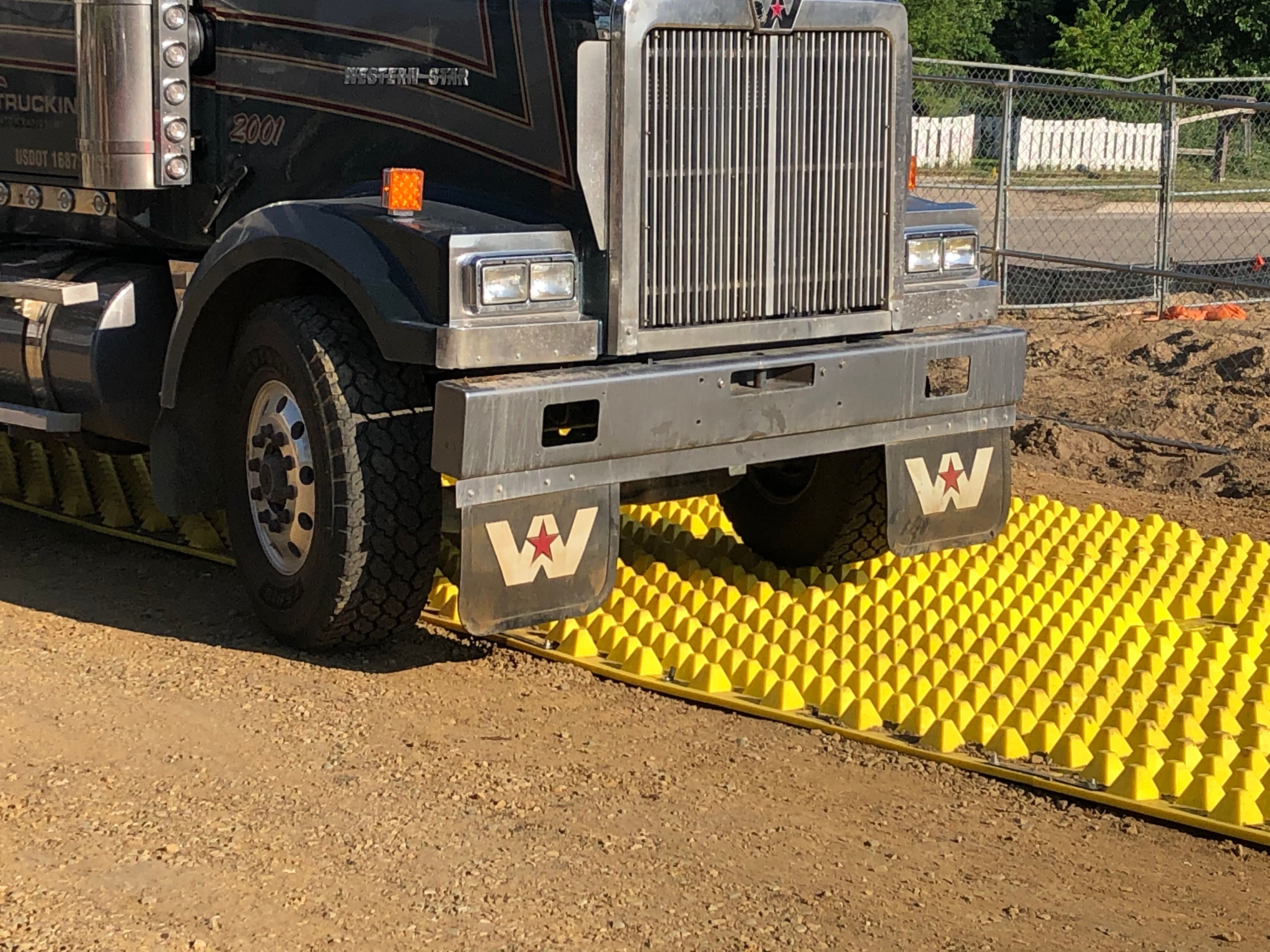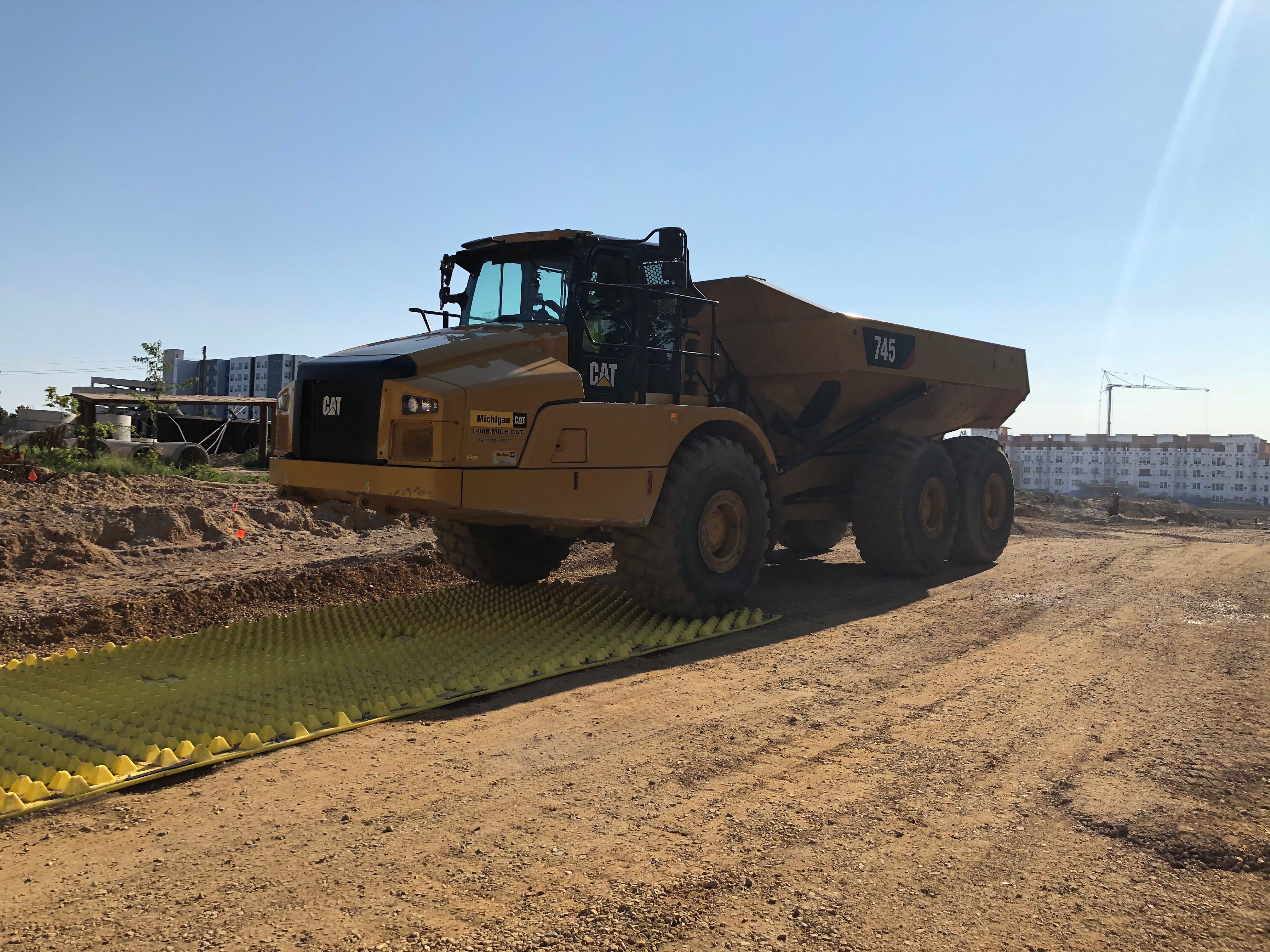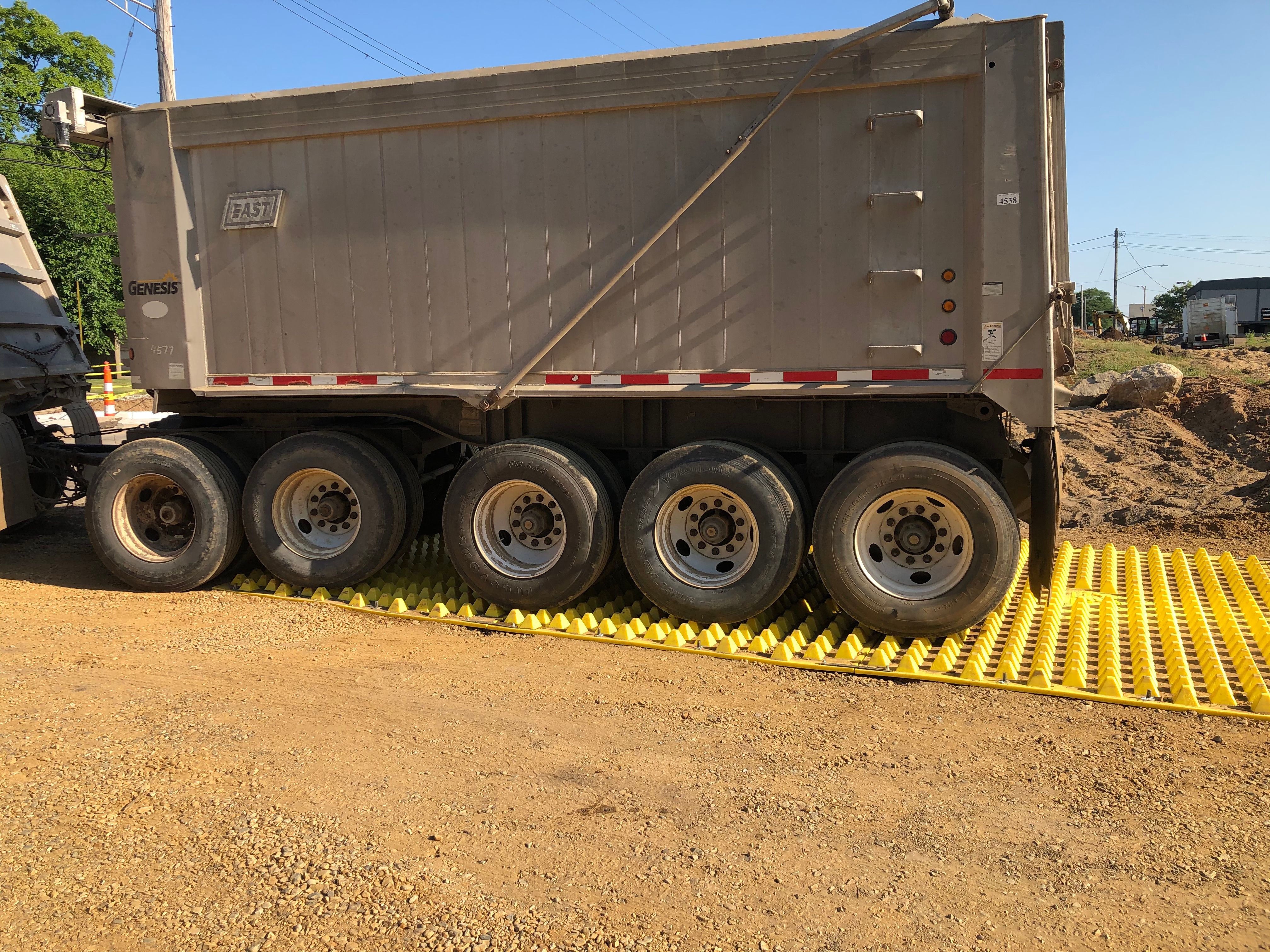Michigan Stabilized Construction Access Road
Michigan is home to Detroit, the “Motor City,” which left a mark on modern culture at the turn of the century. In 1908, Henry Ford built the Model T and introduced the assembly line production method to the automotive industry which enabled lower cost manufacturing and wider adoption to motor vehicles. Besides the manufacturing industry, Michigan is also a major agricultural hub of dairy and crops.
The state of Michigan has the longest freshwater shoreline in the world being surrounded by four of the five Great Lakes. The northern Lake Superior holds 10% of the worlds freshwater reserves. The proximity to these precious water resources spurred proactive water quality protection measures to keep the lakes and rivers free of excessive sedimentation or pollution.
Michigan Department of Environment, Great Lakes, and Energy (EGLE)
Formerly called the Michigan DEQ, the Michigan Department of Environment, Great Lakes, and Energy (EGLE) regulates and oversees the quality of water across the state. Because of the state’s major freshwater resources, they were proactively took steps to establish regulation to preserve the water quality. The state had already implemented the Water Resources Commission Act (“Act 245”) in 1929 to protect water quality when the Federal Clean Water Act was passed in 1972. Further regulation was passed to and Part 91, Soil Erosion and Sediment Control, of the Natural Resources and Environmental Protection Act (NREPA) is currently the primary regulation regarding stormwater in the state. Part 91 requires the issuance of Soil Erosion and Sediment Control (SESC) permits before operators discharge to any surface waters.
Part 91 SESC Permits
Part 91, Soil Erosion and Sediment Control permits (SESC permits or “Part 91 Permit”) are administered and enforced by localities such as county and local agencies. Counties are required to administer and enforce Part 91, including the establishement of a County Enforcing Agency (CEA). In addition, many cities, townships and local governments have elected to establish a Municipal Enforcing Agency (MEAs) which will assume responsibility to issue SESC permits and ensure compliance with Part 91 in their jurisdiction.
The application process involves the creation of an SESC plan. The SESC plan includes various details about the projects including a map, distance between earth disturbances and water features, description of site drainage, schedule of earth disturbing activities, a description and location of all SESC measures, and a maintenance program for SESC measures.

Permit-by Rule
The Federal Clean Water act established the National Pollution Discharge Elimination System (NPDES) permit program which is commonly regulated under three types of permits: Construction, Industrial, and Municipal. The Michigan EGLE integrated the NPDES Permit program under a “Permit-by Rule” process to prevent contractors and site operators from needing to obtain two stormwater permits. Any construction projects that disturb between one and five acres of land are automatically permitted under the NPDES when they receive the SECE “Part 91” permit from the local permitting authority. For sites disturbing five or more acres of land, the operator must also submit a Notice of coverage (NOC) to the EGLE Water Resources Division (WRD) along with a copy of the SESC plan, map and applicable fee. EGLE's Water Resources Division (WRD) uses an online portal, called MiWaters, for all document submissions related to stormwater permits. The portal is used to submit permit applications, discharge reporting, and supporting documents as well as to receive real time updates from the EGLE so contractors can quickly make changes to address potential permit violations.
Michigan Stabilized Construction Access Road Specification (S53)
One of the first SESC measures, or Best Management Practices (BMPs), used on any construction site is the Access Roads or Stabilized Construction Access. The purpose of a Stabilized Construction Access Road is to prevent the migration of sediment from disturbed areas onto roadways by vehicle traffic. If sediment is deposited onto paved or impermeable roadways, rain events can wash the debris into storm drains or surface waters. The Access Road, also called Exit Road or Stabilized Construction Access, should be installed at all points where vehicular traffic exits the job site. Any roadways leaving the site that are not stabilized should be blocked to prevent construction traffic from exiting.
The various organizations and departments have produced guidebooks and manuals with specifications for the Stabilized Construction Access or Access Roads commonly used in the state of Michigan. The EGLE links to these other standards and guides to help contractors and engineers in the planning of a construction project. Each of these guidebooks use a different name to refer to the Access Road SESC measure.

EGLE BMP Access Road
The EGLE BMP Manual includes the Access Road Design Reference in the Surface Water section of their website. The Access Road is constructed of 2-3 inch diameter washed aggregate, stone or crushed concrete that is laid over a non-woven geotextile fabric. The Design Reference recommends use of angular or crushed aggregate to increase pore space, longevity and effectiveness. The stone size should be increased for heavy equipment and the stone size should be such that the aggregate is not wedged between dual tire vehicles. The minimum dimensions are 50’ in length and 10 feet in width with a wider turning radius. The depth of the Access Road should be at least 6 inches of 2-3 inch stone, but should be deeper if larger stones are used. The area should have drainage and measures to contain runoff within the job site.
The contractor is required to inspect the Access Road daily as it is in use for signs of failure. When sediment begins tracking onto the roadway, the rock may have become rutted and stone could be migrating into the sub-base. The solution is to repair the failures and immediately sweep the roadway to prevent sediment from entering storm drains. When repairs are frequently required, contractors may opt to increase the length of the entrance or install a tire wash with proper drainage (eg. Sediment Basin).
Tire washing is mentioned as a way to improve effectiveness as well as “drive-on” corrugated or ribbed steel plates. These techniques are used to dislodge additional sediment from tires. Proper drainage should be installed to prevent runoff from carrying sediment laden water into the roadway, especially when tire washing is implemented.
DTMB SESC Guidebook (S53) Stabilized Construction Access
The Department of Technology, Management and Budget SESC Soil Erosion and Sedimentation Control Guidebook includes specifications for the (S53) Stabilized Construction Access. This guidebook is used to inform State of Michigan construction projects. The stated purpose of the (S53) Stabilized Construction Access is to minimize tracking of sediment onto public roadways and to minimize disturbance of vegetation. The Stabilized Construction Access should be installed at all points where construction traffic leaves the site and all vehicles must be routed to use the rock ingress/egress. The Guidebook states that the scope of work of installation should fall to the site clearing or excavating contractor and that the Stabilized Construction Access area should be cleared of woody vegetation prior to commencing grading of the site. The minimum dimensions recommended in this guide are 50’ in length and 12’ in width, however for a residence lot the minimum Stabilized Construction Access length may be reduced to 30’. The depth mentioned here is 8” of 2-3” crushed rock. The entrance should be inspected regularly as well as after each rain event, and the stabilized entrance should be repaired by adding rock as needed.
A wash rack may be needed if the (S53) Stabilized Construction Access is not sufficient to clean vehicle tires. The tires should be washed over a stabilized area and before other techniques such as the rock stabilized entrance. Any sediment that is tracked onto roadways must be removed immediately and returned to the construction site to prevent the sediment from washing down a storm drain or into nearby surface waters.

MDOT SESC Manual Gravel Access Approach
The MDOT Soil Erosion and Sediment Control Manual includes specifications for highway and public roadway projects. The technique here is called Gravel Access Approach and is designed to minimize the tracking of loose materials from the construction site onto public roadways. The Manual recommends coarser aggregate which is more effective, and regular replenishment of aggregate when the Gravel Access Approach is no longer preventing tracking.
MACDC SESC Manual 28. Stone Construction Access
Lastly, the Michigan Association of County Drain Commissioners creates the MACDC SESC Manual with mention of the 28. Stone Construction Access. The goal of this technique is to minimize fugitive dust and tracking of soil onto roadways. The minimum dimensions listed are 50’ long and 12’ wide or as required to match the specific job site. The optional Diversion Ridge might be needed to contain runoff on-site if the grade of the exit is toward the roadway. The specifics of the entrance are to be specified by the engineer.
FODS Modern Stabilized Construction Entrance
FODS Trackout Control Mat System is designed to stabilized the egress and ingress points on a construction project or industrial site to minimize tracking of sediment onto roadways. This technique is used to replace the various techniques mentioned in the manuals and guidebooks including:
- Access Road
- Stabilized Construction Access
- Gravel Access Approach
- Stone Construction Access
The Stabilized Construction Access pads are a modern, and highly effective solution to job site trackout. The system is composed of durable high density polyethylene (HDPE) mats which are formed into pyramid shapes which function similar to the rough edges on crushed stone.
Highly Effective
The pyramids deform vehicle tires and open tires treads allowing sediment and debris to break loose. Since the vehicle tires ride on the tops of the pyramids, the base of the pyramids mimics the voids or pores in a traditional Access Road. The system has been demonstrated to reduce street sweeping by 59% on high traffic projects.
Easily Maintained
The mats can hold up to 2.5” of sediment before vehicle tires come into contact with previously deposited debris. The system is easily maintained onsite without requiring additional materials by quick and simple cleaning methods including: skid steer with broom attachment, powered sweeper, street sweeper, or cleaning manually with a FODS shovel.
Increased Safety
Because the system does not use aggregate any size vehicles can use the system and there is system does not introduce the risk of aggregate becoming wedged in dual tire vehicles. The rockless system also reduces risk of aggregate migrating to active roadways, which makes the system ideal for highway and urban environments.
Durable & Reusable
The system is reusable and portable allowing contractors to reuse on multiple locations during subsequent job phases and continue using onto the next project. The mats are designed for heavy duty use and have an expected service life of 10+ years allowing contractors to stay compliant and reduce costs.
Additional Resources:
EGLE Individual BMPs - Access Road
DTMB SESC Guidebook - (S53) Stabilized Construction Access
MDOT Manuals and Guidelines - Soil Erosion and Sedimentation Control Manual - Gravel Access Approach
MACDC SESC Manual - 28. Stone Construction Access

